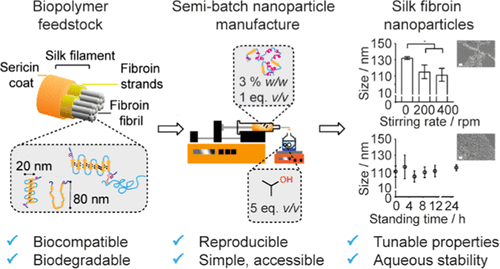当前位置:
X-MOL 学术
›
ACS Biomater. Sci. Eng.
›
论文详情
Our official English website, www.x-mol.net, welcomes your
feedback! (Note: you will need to create a separate account there.)
Silk Nanoparticle Manufacture in Semi-Batch Format
ACS Biomaterials Science & Engineering ( IF 5.4 ) Pub Date : 2020-11-03 , DOI: 10.1021/acsbiomaterials.0c01028 Saphia A. L. Matthew 1 , John D. Totten 1, 2 , Suttinee Phuagkhaopong 1 , Gemma Egan 1 , Kimia Witte 1 , Yvonne Perrie 1 , F. Philipp Seib 1, 2, 3
ACS Biomaterials Science & Engineering ( IF 5.4 ) Pub Date : 2020-11-03 , DOI: 10.1021/acsbiomaterials.0c01028 Saphia A. L. Matthew 1 , John D. Totten 1, 2 , Suttinee Phuagkhaopong 1 , Gemma Egan 1 , Kimia Witte 1 , Yvonne Perrie 1 , F. Philipp Seib 1, 2, 3
Affiliation

|
Silk nanoparticles have demonstrated utility across a range of biomedical applications, especially as drug delivery vehicles. Their fabrication by bottom-up methods such as nanoprecipitation, rather than top-down manufacture, can improve critical nanoparticle quality attributes. Here, we establish a simple semi-batch method using drop-by-drop nanoprecipitation at the lab scale that reduces special-cause variation and improves mixing efficiency. The stirring rate was an important parameter affecting nanoparticle size and yield (400 < 200 < 0 rpm), while the initial dropping height (5.5 vs 7.5 cm) directly affected nanoparticle yield. Varying the nanoparticle standing time in the mother liquor between 0 and 24 h did not significantly affect nanoparticle physicochemical properties, indicating that steric and charge stabilizations result in high-energy barriers for nanoparticle growth. Manufacture across all tested formulations achieved nanoparticles between 104 and 134 nm in size with high β-sheet content, spherical morphology, and stability in aqueous media for over 1 month at 4 °C. This semi-automated drop-by-drop, semi-batch silk desolvation offers an accessible, higher-throughput platform for standardization of parameters that are difficult to control using manual methodologies.
中文翻译:

半批量生产丝纳米颗粒
蚕丝纳米颗粒已证明可用于多种生物医学应用,尤其是作为药物传递载体。通过自下而上的方法(例如纳米沉淀法)而不是自上而下的制造方法,可以改善关键的纳米颗粒质量属性。在这里,我们建立了一种在实验室规模上使用逐滴纳米沉淀的简单半间歇方法,该方法可以减少特殊原因的变化并提高混合效率。搅拌速率是影响纳米颗粒尺寸和产率(400 <200 <0 rpm)的重要参数,而初始下降高度(5.5 vs 7.5 cm)直接影响纳米颗粒产率。在母液中的纳米颗粒停留时间在0到24小时之间变化不会显着影响纳米颗粒的理化特性,表明空间和电荷稳定化会导致纳米粒子生长的高能垒。在所有测试配方中进行的制造均获得了104至134 nm的纳米粒子,具有高的β-折叠含量,球形形态以及在水性介质中在4°C下可保持1个月以上的稳定性。这种半自动化的逐滴,半批量丝绸去溶剂化工艺提供了一个可访问的,高通量的平台,用于标准化难以使用手动方法控制的参数。
更新日期:2020-12-14
中文翻译:

半批量生产丝纳米颗粒
蚕丝纳米颗粒已证明可用于多种生物医学应用,尤其是作为药物传递载体。通过自下而上的方法(例如纳米沉淀法)而不是自上而下的制造方法,可以改善关键的纳米颗粒质量属性。在这里,我们建立了一种在实验室规模上使用逐滴纳米沉淀的简单半间歇方法,该方法可以减少特殊原因的变化并提高混合效率。搅拌速率是影响纳米颗粒尺寸和产率(400 <200 <0 rpm)的重要参数,而初始下降高度(5.5 vs 7.5 cm)直接影响纳米颗粒产率。在母液中的纳米颗粒停留时间在0到24小时之间变化不会显着影响纳米颗粒的理化特性,表明空间和电荷稳定化会导致纳米粒子生长的高能垒。在所有测试配方中进行的制造均获得了104至134 nm的纳米粒子,具有高的β-折叠含量,球形形态以及在水性介质中在4°C下可保持1个月以上的稳定性。这种半自动化的逐滴,半批量丝绸去溶剂化工艺提供了一个可访问的,高通量的平台,用于标准化难以使用手动方法控制的参数。





















































 京公网安备 11010802027423号
京公网安备 11010802027423号